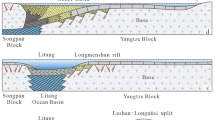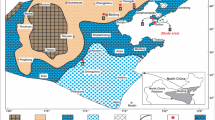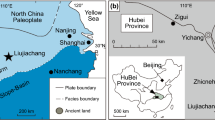Abstract
This study focuses on an extensive biostromal microbialite (10–20 m in thickness and over 6,000 km2 in area) and the overlying grainstones in the Furongian Chaomidian Formation, Shandong Province, China in order to understand the demise of the microbialite. The microbialites are characterized by centimeter-to decimeter-scale maze-like maceria structures and/or chaotic mesostructures. According to the megastructures of microbialites and the proportion of non-microbial carbonate sediment, the biostromal microbialite is generally divided into the lower and the upper parts, separated by a distinct surface. The lower part is laterally continuous and generally flat-bedded, whereas the upper part shows variable domal megastructures and locally co-occurs with abundant non-microbial carbonate sediment. The entire microbialite bed is sharply overlain by grainstone-dominated deposits via an erosion surface which is either irregular with significant relief or flat with hematitic coating. The lower part of the biostromal microbialites with flat-bedded megastructures most likely deposited contemporaneously during sea-level highstand in the early middle Furongian, as evinced by well-correlated flat-bedded units separated by distinct bounding surfaces. The microbialites formed regional topographic variation, generally deepening toward southeast. The flat-bedded microbialites were drowned by subsequent rapid rise in sea level. In the topographic highs, the microbialites caught up with sea-level rise, forming large-scale domal megastructures. In the topographic lows, however, domal microbialites formed together with abundant non-microbial sediment, which were frequently reworked by storm-induced waves and currents. Subsequent deposition and migration of coarse-grained non-microbial sediment during sea-level rise terminated the entire microbialites.
Similar content being viewed by others
References
Adams, E.W., Grotzinger, J.P., Watters, W.A., Schröder, S., McCormick, D.S., and Al-Siyabi, H.A., 2005, Digital characterization of thrombolite-stromatolite reef distribution in a carbonate ramp system (terminal Proterozoic, Nama Group, Namibia). AAPG Bulletin, 89, 1293–1318.
Aitken, J.D., 1967, Classification and environmental significance of cryptalgal limestones and dolomites, with illustrations from the Cambrian and Ordovician of southwestern Alberta. Journal of Sedimentary Petrology, 37, 1163–1178.
Allen, J.R.L., 1982, Sedimentary Structures: Their Character and Physical Basis. Elsevier, Amsterdam, 663 p.
Allen, P.A., 1985, Hummocky cross-stratification is not produced purely under progressive gravity waves. Nature, 313, 562–564.
Betzler, C., Pawellek, T., Abdullah, M., and Kossler, A., 2007, Facies and stratigraphic architecture of the Korallenoolith Formation in North Germany (Lauensteiner Pass, Ith Mountains). Sedimentary Geology, 194, 61–75.
Bowlin, E.M., Klaus, J.S., Foster, J.S., Andres, M.S., Custals, L., and Reid, R.P., 2012, Environmental controls on microbial community cycling in modern marine stromatolites. Sedimentary Geology, 263–264, 45–55.
Brett, C.E. and Brookfield, M.E., 1984, Morphology, faunas and genesis of Ordovician hardgrounds from southern Ontario, Canada. Palaeogeography, Palaeoclimatology, Palaeoecology, 46, 233–290.
Calvet, F. and Tucker, M.E., 1988, Outer ramp cycles in the Upper Muschelkalk of the Catalan Basin, northeast Spain. Sedimentary Geology, 57, 185–198.
Campbell, J.A., 1976, Upper Cambrian stromatolitic biostrome, Clinetop Member of the Dotsero Formation, western Colorado. Geological Society of America Bulletin, 87, 13–31.
Caron, V., Nelson, C.S., and Kamp, P.J.J., 2004, Transgressive surfaces of erosion as sequence boundary markers in cool-water shelf carbonates. Sedimentary Geology, 164, 179–189.
Chen, J., Chough, S.K., Chun, S.S., and Han, Z., 2009a, Limestone pseudoconglomerates in the Late Cambrian Gushan and Chaomidian Formations (Shandong Province, China): soft-sediment deformation induced by storm-wave loading. Sedimentology, 56, 1174–1195.
Chen, J., van Loon, A.J., Han, Z., and Chough, S.K., 2009b, Funnelshaped, breccia-filled clastic dykes in the Late Cambrian Chao midian Formation (Shandong Province, China). Sedimentary Geology, 221, 1–6.
Chen, J., Chough, S.K., Han, Z., and Lee, J.-H., 2011, An extensive erosion surface of a strongly deformed limestone bed in the Gushan and Chaomidian formations (late Middle Cambrian to Furongian), Shandong Province, China: Sequence-stratigraphic implications. Sedimentary Geology, 233, 129–149.
Chough, S.K., Kwon, Y.K., Choi, D.K., and Lee, D.J., 2001, Autoconglomeration of limestone. Geosciences Journal, 5, 159–164.
Chough, S.K., Lee, H.S., Woo, J., Chen, J., Choi, D.K., Lee, S.-b., Kang, I., Park, T.-Y., and Han, Z., 2010, Cambrian stratigraphy of the North China Platform: revisiting principal sections in Shandong Province, China. Geosciences Journal, 14, 235–268.
Demicco, R.V. and Hardie, L.A., 1994, Sedimentary structures and early diagenetic features of shallow marine carbonates. SEPM, Tulsa, 265 p.
Dibenedetto, S. and Grotzinger, J., 2005, Geomorphic evolution of a storm-dominated carbonate ramp (c. 549 Ma), Nama Group, Namibia. Geological Magazine, 142, 583–604.
Grotzinger, J.P., 1989, Facies and evolution of Precambrian carbonate depositional systems: emergence of the modern platform archetype. In: Crevello, P.D., Wilson, J.L., Sarg, J.F., and Read, J.F. (eds.), Controls on Carbonate Platforms and Basin Development. SEPM, Tulsa, 79–106.
Grotzinger, J.P., Adams, E.W., and Schröder, S., 2005, Microbial-metazoan reefs of the terminal Proterozoic Nama Group (c. 550-543 Ma), Namibia. Geological Magazine, 142, 499–517.
Howell, J., Woo, J., and Chough, S.K., 2011, Dendroid morphology and growth patterns: 3-D computed tomographic reconstruction. Palaeogeography, Palaeoclimatology, Palaeoecology, 299, 335–347.
Keller, M., 1997, Evolution and sequence stratigraphy of an Early Devonian carbonate ramp, Cantabrian Mountains, northern Spain. Journal of Sedimentary Research, 67, 638–652.
Kershaw, S., 1994, Classification and Geological Significance of Biostromes. Facies, 31, 81–92.
Kershaw, S., Zhang, T.S., and Lan, G.Z., 1999, A ?microbialite carbonate crust at the Permian-Triassic boundary in South China, and its palaeoenvironmental significance. Palaeogeography, Palaeoclimatology, Palaeoecology, 146, 1–18.
Kiessling, W., Flügel, E., and Golonka, J., 2002, Phanerozoic Reef Patterns. SEPM, Tulsa, 775 p.
Kreisa, R.D., 1981, Storm-generated sedimentary structures in subtidal marine facies with examples from the Middle and Upper Ordovician of Southwestern Virginia. Journal of Sedimentary Petrology, 51, 823–848.
Kumar, N. and Sanders, J.E., 1976, Characteristics of shoreface storm deposits: modern and ancient examples. Journal of Sedimentary Petrology, 46, 145–162.
Kwon, Y.K., Chough, S.K., Choi, D.K., and Lee, D.J., 2002, Origin of limestone conglomerates in the Choson Supergroup (Cambro-Ordovician), mid-east Korea. Sedimentary Geology, 146, 265–283.
Kwon, Y.K. and Chough, S.K., 2005, Sequence stratigraphy of the cyclic successions in the Dumugol Formation (Lower Ordovician), mideast Korea. Geosciences Journal, 9, 305–324.
Kwon, Y.K., Chough, S.K., Choi, D.K., and Lee, D.J., 2006, Sequence stratigraphy of the Taebaek Group (Cambrian-Ordovician), mideast Korea. Sedimentary Geology, 192, 19–55.
Lee, H.S. and Chough, S.K., 2011, Depositional processes of the Zhushadong and Mantou formations (Early to Middle Cambrian), Shandong Province, China: roles of archipelago and mixed carbonate-siliciclastic sedimentation on cycle genesis during initial flooding of the North China Platform. Sedimentology, 58, 1530–1572.
Lee, J.-H., Chen, J., and Chough, S.K., 2010, Paleoenvironmental implications of an extensive maceriate microbialite bed in the Furongian Chaomidian Formation, Shandong Province, China. Palaeogeography, Palaeoclimatology, Palaeoecology, 297, 621–632.
Lemon, N.M., 2000, Neoproterozoic fringing stromatolite reef complex, Flinders Ranges, South Australia. Precambrian Research, 100, 109–120.
Markello, J.R. and Read, J.F., 1981, Carbonate ramp-to-deeper shale shelf transitions of an Upper Cambrian intrashelf basin, Nolichucky Formation, Southwest Virginia Appalachians. Sedimentology, 28, 573–597.
Meng, X., Ge, M., and Tucker, M.E., 1997, Sequence Sequence stratigraphy, sea-level changes and depositional systems in the Cambro-Ordovician of the North China carbonate platform. Sedimentary Geology, 114, 189–222.
Meyerhoff, A.A., Kamen-Kaye, M., Chen, C., and Taner, I., 1991, China — Stratigraphy, Paleogeography, and Tectonics. Kluwer Academic Publishers, Dordrecht, Netherlands, 188 p.
Moshier, S.O., 1986, Carbonate Platform Sedimentology, Upper Cambrian Richland Formation, Lebanon Valley, Pennsylvania. Journal of Sedimentary Petrology, 56, 204–216.
Myrow, P.M. and Southard, J.B., 1996, Tempestite deposition. Journal of Sedimentary Research, 66, 875–887.
Myrow, P.M., Taylor, J.F., Miller, J.F., Ethington, R.L., Ripperdan, R.L., and Brachle, C.M., 1999, Stratigraphy, sedimentology, and paleontology of the Cambrian-Ordovician of Colorado. In: Lageson, D.R., Lester, A.P., and Trudgill, B.D. (eds.), Colorado and Adjacent Areas. Geological Society of America, Boulder, 157–176.
Nichols, G., 2009, Sedimentology and Stratigraphy (2nd edition). Wiley-Blackwell, Oxford, 419 p.
Osleger, D., 1991, Subtidal carbonate cycles: Implications for allocyclic vs. autocyclic controls. Geology, 19, 917–920.
Osleger, D. and Read, J.F., 1991, Relation of eustasy to stacking patterns of meter-scale carbonate cycles, Late Cambrian, USA. Journal of Sedimentary Petrology, 61, 1225–1252.
Palma, R.M., López-Gómez, J., and Piethé, R.D., 2007, Oxfordian ramp system (La Manga Formation) in the Bardas Blancas area (Mendoza Province) Neuquén Basin, Argentina: Facies and depositional sequences. Sedimentary Geology, 195, 113–134.
Pfeil, R.W. and Read, J.F., 1980, Cambrian carbonate platform margin facies, Shady Dolomite, southwestern Virginia, U.S.A. Journal of Sedimentary Petrology, 50, 91–116.
Read, J.F., 1985, Carbonate platform facies models. AAPG Bulletin, 69, 1–21.
Rowland, S. and Shapiro, R.S., 2002, Reef patterns and environmental influences in the Cambrian and earliest Ordovician. In: Kiessling, W., Flügel, E., and Golonka, J. (eds.), Phanerozoic Reef Patterns. SEPM, Tulsa, 95–128.
Sami, T.T. and James, N.P., 1994, Peritidal carbonate platform growth and cyclicity in an early Proterozoic foreland basin, Upper Pethei Group, northwest Canada. Journal of Sedimentary Research, B64, 111–131.
Scotese, C.R. and McKerrow, W.S., 1990, Revised world maps and introduction. In: McKerrow, W.S. and Scotese, C.R. (eds.), Palaeozoic Palaeogeography and Biogeography. Geological Society, 1–21.
Shinn, E.A., Steinen, R.P., Dill, R.F., and Major, R., 1993, Lime-mud layers in high-energy tidal channels: A record of hurricane deposition. Geology, 21, 603–606.
Southgate, P.N., 1989, Relationships between cyclicity and stromatolite form in the Late Proterozoic Bitter Springs Formation, Australia. Sedimentology, 36, 323–339.
Strasser, A., 1986, Ooids in Purbeck limestones (lowermost Cretaceous) of the Swiss and French Jura. Sedimentology, 33, 711–727.
Tucker, M.E., 1977, Stromatolite biostromes and associated facies in the late Precambrian porsanger dolomite formation of Finnmark, Arctic Norway. Palaeogeography, Palaeoclimatology, Palaeoecology, 21, 55–83.
Tucker, M.E. and Wright, V.P., 1990, Carbonate Sedimentology. Blackwell, Oxford, 482 p.
Turner, E.C., James, N.P., and Narbonne, G.M., 1997, Growth dynamics of Neoproterozoic calcimicrobial reefs, Mackenzie Mountains, Northwest Canada. Journal of Sedimentary Research, 67, 437–450.
Walker, R.G. and Plint, A., 1992, Wave- and storm-dominated shallow marine systems. In: Walker, R.G. and James, N.P. (eds.), Facies Models: Response to Sea Level Change. Geological Association of Canada, St. John’s, 219–238.
Woo, J., Chough, S.K., and Han, Z., 2008, Chambers of Epiphyton thalli in microbial buildups, Zhangxia Formation (Middle Cambrian), Shandong Province, China. Palaios, 23, 55–64.
Woo, J., 2009, The Middle Cambrian Zhangxia Formation, Shandong Province, China: Depositional Environments and Microbial Sedimentation, Ph.D. thesis, Seoul National University, Seoul, 243 p.
Woo, J. and Chough, S.K., 2010, Growth patterns of the Cambrian microbialite: Phototropism and speciation of Epiphyton. Sedimentary Geology, 229, 1–8.
Author information
Authors and Affiliations
Corresponding author
Rights and permissions
About this article
Cite this article
Lee, JH., Chen, J. & Chough, S.K. Demise of an extensive biostromal microbialite in the Furongian (late Cambrian) Chaomidian Formation, Shandong Province, China. Geosci J 16, 275–287 (2012). https://doi.org/10.1007/s12303-012-0027-2
Received:
Accepted:
Published:
Issue Date:
DOI: https://doi.org/10.1007/s12303-012-0027-2




